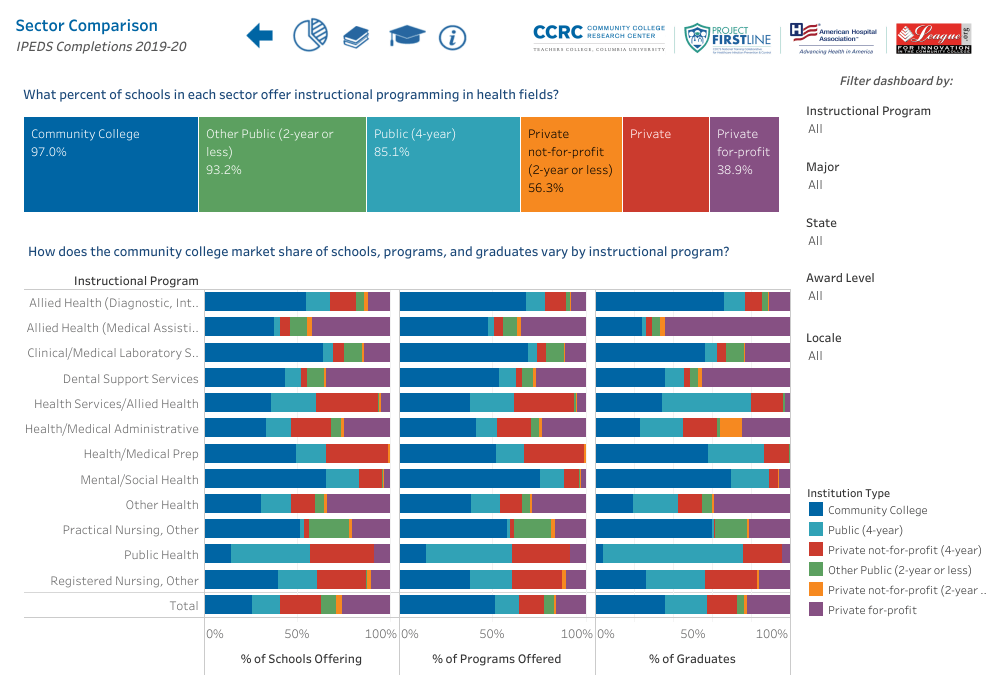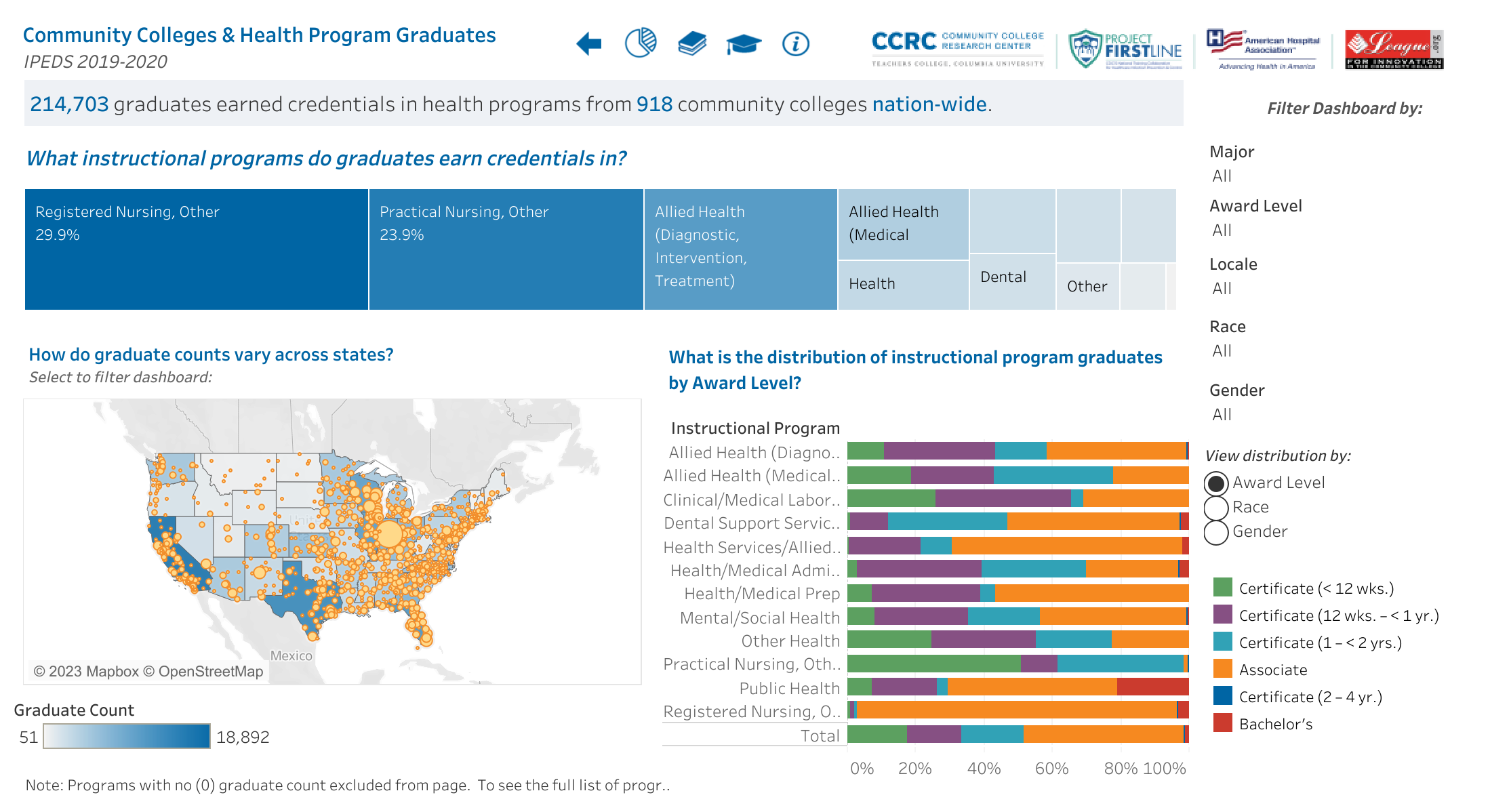Community colleges are essential institutions for training America’s frontline healthcare workers. Most public two-year colleges offer nursing programs along with certificate and degree programs in allied health and a variety of other health-related fields. The COVID-19 pandemic has illuminated how much the country depends on community colleges to maintain, renew, and strengthen our healthcare system. Hospitals, medical offices, community clinics, and testing facilities are all facing enormous strain and an increasing need for nurses, medical assistants, and other well-trained workers. Community colleges are accessible and affordable, serve all states and regions of the country, and have the infrastructure and programming needed to train students in locations where healthcare workers are needed most.
To better understand the role that community colleges play in training healthcare workers, CCRC analyzed data from the U.S. Department of Education’s Integrated Postsecondary Education Data System (IPEDS) 2019-20 survey to describe the availability of health-related programs—including nursing, allied health, and public health—and the number and characteristics of students who completed credentials in those programs. Drawing on this analysis, we created an interactive data visualization tool to help practitioners, policymakers, and health professional organizations gain more detailed information about healthcare training in community colleges. The tool focuses on three areas:
- Sector comparison: What percentage of schools in each postsecondary sector offer instructional programming in healthcare fields? What is the community college market share of schools, programs, and graduates?
- Community college program access: Which instructional programs are offered most in community colleges?
- Community college program graduates: What instructional programs do community college graduates earn credentials in?
Using the tool, users can explore each sector and access results by instructional program, state, and urbanicity of the campus. Users can also explore the distribution of program graduates by award level and by student race/ethnicity and gender.
Find your college’s data: Examining the Role of Community Colleges in Training Healthcare Workers
How does the community college market share of schools, programs, and graduates vary by instructional program?
To gain a better understanding of the healthcare training role that community colleges play relative to other postsecondary institutions, the tool allows users to examine the availability of nursing, allied health, and public health programs across postsecondary sectors. (For the purposes of the analysis, we counted institutions as community colleges if they were funded primarily by state and local sources and mainly offered sub-baccalaureate credentials. Some also offer bachelor’s degrees.)
A screenshot of the tool below shows that community colleges hold the largest market share of program offerings in four instructional program groups: Mental/Social Health (76%), Allied Health (Diagnostic, Intervention, Treatment) (68%), Clinical/Medical Laboratory Science (69%), and Practical Nursing (58%). In comparison, private not-for-profit four-year and public four-year colleges account for nearly half of programs in Registered Nursing (49%) and a majority of programs in Health Services/Allied Health (56%) and Public Health (77%).

Users can also explore the proportion of credentials conferred at any level (i.e., short-term certificate, long-term certificate, associate degree, bachelor’s degree) by postsecondary institution type. Overall, among the healthcare programs considered in this study, most credentials conferred during the 2019-20 academic year (57%) were awarded by either community colleges (36%) or private for-profits (22%).
Which instructional programs are most offered in community colleges?
Equipped with a better understanding of the role each sector plays in providing healthcare programs to students, users can drill down to see which instructional programs are most offered in community colleges and filter by specific majors. For example, the screenshot below shows that 265 community colleges offer Respiratory Care Therapy/Therapist programs and that the overwhelming majority of these programs award associate degrees. The national map illustrates where these programs are located, with the largest concentrations in California and Texas.

What instructional programs do community college graduates earn credentials in?
Through the tool, users can examine community college instructional program groups by number of awards conferred and disaggregate the data by award level. This allows comparison of the distribution of awards conferred in each instructional program group to the overall distribution of healthcare awards at the colleges.

Overall, during the 2019-20 academic year, community college healthcare program completers were most likely to earn an associate degree (47%). Associate degrees were most frequently awarded in the following instructional program groups: Allied Health (Diagnostic, Intervention, Treatment), Dental Support Services, Health Services/Allied Health, Health/Medical Prep, Mental/Social Health, Public Health, and Registered Nursing. For many healthcare programs, completions of shorter-term certificates are more common than completions of longer-term awards. Indeed, most students graduating from programs in Practical Nursing, Allied Health (Medical Assisting), Clinical/Medical Laboratory Science, Health/Medical Administrative, and Other Health earned certificates that take between 12 weeks and 1–2 years to complete, suggesting that shorter programs awarding workforce credentials may be more attractive and/or accessible to students in certain healthcare fields.
This tool can provide policymakers and community college leaders a better understanding of the role community colleges currently play and their potential to take on greater responsibility in training healthcare workers. An accompanying research report summarizes findings from the analysis.





